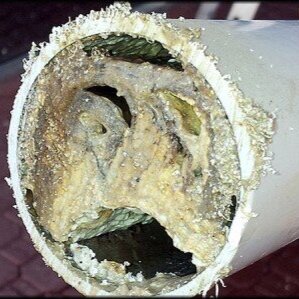HIRE A HOUSEWIFE’S GUIDE, HOW TO NATURALLY CLEAN A CLOGGED DRAIN:
/Learn how to naturally clean a clogged drain and unstop a slow running sink without using toxic chemicals or calling a plumber!
COMMERCIAL DRAIN CLEANERS
Being forced to use dangerous chemicals to unclog backed up sinks and clean slow flowing drains in this day and age can be unsettling as we are all living in a more environmentally friendly time.
Get rid of toxic chemicals and learn the easy way to naturally clean a clogged drain and speed up slow flowing pipes.
WHAT CAUSES DRAIN CLOGS?
You cannot clean and declog if you don’t know the cause of the problem.
Most household drain clogs are caused by four substances.
KITCHEN SINK CLOG CAUSES
Fat, Oil and Grease. Fatty substances are the number one cause of kitchen sink clogs and slow draining sinks. – they go down the drain easily in a liquid state (think hot grease in a pan or dissolved fat in warm dishwater) BUT as they move through your pipes the fat cools. This solid fat coats the pipes’ insides getting thicker and thicker until you have a slow drain or complete blockage.
Food Particles: Large food particles or vegetable peels that become trapped in the curved pipe beneath the sink are another common cause of kitchen drain clogs.
BATHROOM SINK CLOG CAUSES
Hair is the most common cause of bathroom drain clog. The hair easily goes down the drain with water then accumulates inside the pipe building up until the line is blocked. These clogs usually occur right below the drain.
Soap Scum: Greasy soap residue and particles can also coat the interior of pipes and cause a blockage. In some cases the soap buildup can become so bad it can actually corrode the pipes.
THE RIGHT TOOL (OR TRICK) FOR THE CLOG
After you make an educated guess about the cause of the clog, four tools and tricks will help you naturally unclog your drain and remove debris without calling a plumber.
A PLUNGER
Works On: Food particles or objects stuck in the curved pipe beneath your sink. Try this on completely clogged or slow-draining drains.
How to Use: Clear the surrounding area in case of water splashes. Fill the sink halfway with warm water then give your sink a good plunging using a rubber plunger. Rinse drain with hot water.
Why This Works: The plunger dislodges stuck food particles and allows them to pass down through the drain pipe. The water rinse washes them down the drain.
2. LONG WIRE HOOK
Works On: Hair or small objects stuck in bathroom drains. Try this on completely clogged or slow-draining bathroom drains.
How to Use: Bend the end of a long piece of wire into a small hook using pliers (a coat hanger works great) or get a drain cleaning tool
Carefully remove the drain cover, remove any visible debris, then insert the hook. (You’ll want to wear gloves, it is gross.) Pull the hook back up and remove any debris (this will be a bunch of decomposing hair and gunk). Use the hook a few times in the drain to make sure you entirely clear the debris. Dispose of the debris in the garbage.
Why This Works: The hook removes the hair and debris that was blocking the drain, leaving it clean and free-flowing.
3. LIQUID DISH DETERGENT AND HOT WATER
Works On: Grease clogs or fat narrowed pipes. Try this on slow-draining kitchen drains.
How to Use: Heat 2 litres (a large pot of water) to a boil then stir in a few tablespoons of natural hand washing detergent. Slowly pour the nearly boiling water down the slow running drain and then flush with hot tap water. This can take several pans of detergent and hot water.
Why This Works: The hot water melts some of the grease narrowing the pipes, and the dish detergent helps to dissolve the fat. This combination of cleaners removes the gunky buildup and allows drain pipes to run more freely.
4. SALT AND HOT WATER
Works On: Grease or soap clogs and fat or soap narrowed pipes. Try this on slow-draining kitchen and bathroom drains.
How to Use: Pour one-half cup of salt down the slow-moving drain. Heat 2 litres of water until it is nearly boiling then slowly pour down the drain and flush with hot tap water. It may take several rounds of salt and hot water. You can use any type of salt (table salt, sea salt, or kosher salt).
Why This Works: The hot water melts some of the grease that is narrowing the pipes. The salt has an abrasive texture that acts as a natural scouring agent, forcing more greasy build up out. This combination of cleaners removes the gunky buildup and allows drain pipes to run more freely.
5. BIOLOGICAL ENZYME CLEANER
Works On: Organic based clogs like grease, hair, and soap. Try this on slow-draining kitchen and bathroom drains and homes with septic systems. Enzyme cleaners can also be used regularly to keep drains free of organic material and odours.
How to Use: Follow package directions. Best used overnight when drains are not being used.
Why This Works: Biological cleaners contain enzymes and/or bacteria that eat through the organic material in the clog to clear the drain. These cleaners can be used in homes with septic systems because they don’t kill beneficial bacteria.
HOW TO PREVENT DRAIN CLOGS FROM COMING BACK
After you declog a drain, follow these five guidelines to prevent the problem from reoccurring:
1 – Never put FOG (Fats, Oil or Grease) down a drain or garbage disposal. Any substance high in fat (think bacon grease, coconut oil, butter, peanut butter, and other high fat food) should be cooled and then disposed of in the trash or wiped into the trash before washing.
2 – Don’t use hot tap water to melt fats so they can be rinsed down the drain. They will cool and clog your pipes.
3 – Dispose of food waste and vegetable peels in the trash! Do not put onion peels, potato peels, banana peels, egg shells, rice, pasta, celery, and so on down the garbage disposal or sink drain. Check your manufacturer’s guide for details.
4 – Install a hair filter in bathroom drains. Never flush hair down the drain when cleaning, wipe loose strands up and throw them away in the trash.
5 – Flush kitchen drains once a month with salt and hot water. This combination prevents greasy build-up and keeps drains running at full capacity.


